#1890s extant garment
Text

Pink Silk Carriage Boots, 1890-1895.
By Marshall Field, Inc.
Albany Institute of History & Art.
#Marshall field Inc.#womenswear#carriage boots#boots#1890#1890s#1890s boots#1890s shoes#extant garments#1890s extant garment#pink#fur#silk#19th century#Albany institute
1K notes
·
View notes
Text

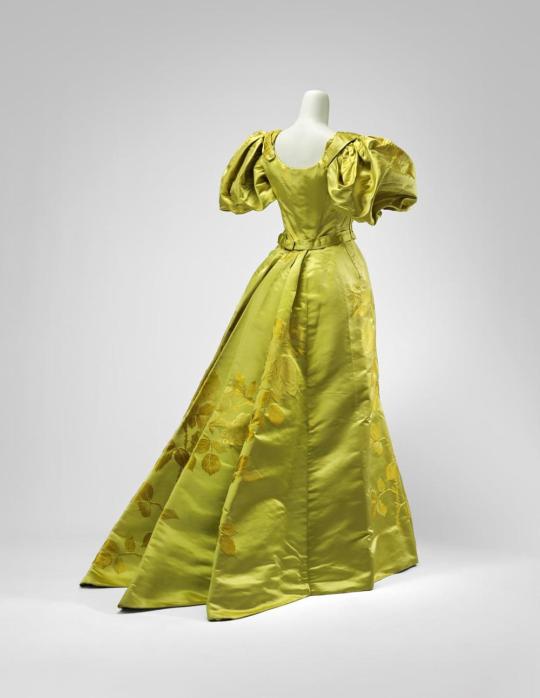
Evening dress by the House of Worth ca. 1895
From MFA Boston
848 notes
·
View notes
Text
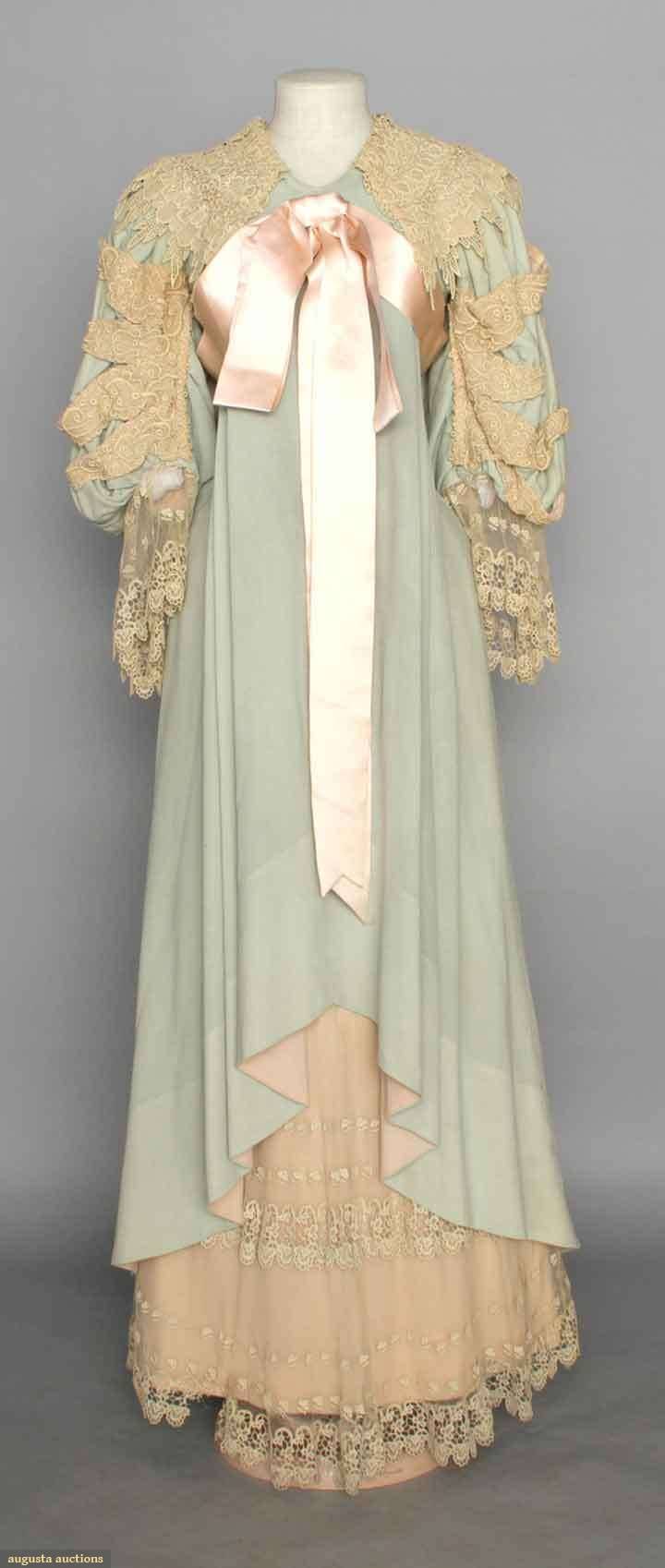

Wool and lace morning gown, c.1895
august auctions
#fashion history#historical fashion#victorian fashion#1890s#1890s fashion#victoriana#edwardian fashion#historical clothing#clothing history#edwardiana#edwardian era#victorian era#19th century fashion#extant garments
779 notes
·
View notes
Text



Title: Evening dress
Design House: House of Worth (French, 1858–1956)
Date: 1898–1900
Culture: French
Medium: silk, cotton
#historical fashion#fashion history#house of worth#evening dress#extant garments#1890s fashion#late victorian fashion#late victorian era
379 notes
·
View notes
Text


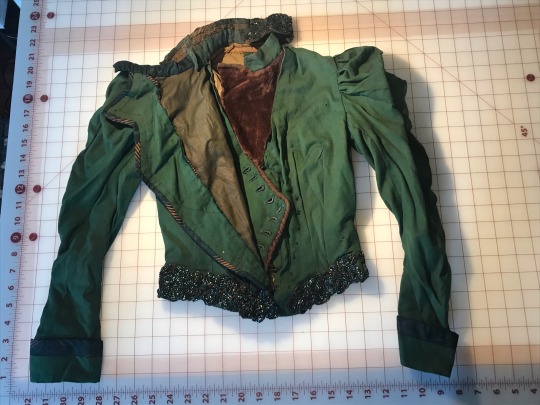
This is an 1890s bodice made of green wool with a linen and/or cotton lining. The front and cuffs are silk. It has steel boning and decorative glass beading. There is a small section of velvet on the inner front. There’s also a small pocket on the left side (from the wearer’s perspective). Not only is this garment gorgeous and unique for the vibrant colors, but also because the beading seems to have been added by the original owner. Hence why it’s laid overtop of striped silk on the collar. It overall has a very handmade and loved feel, it has lots of piecing, the boning was patched after busting out within its life. It seems likely it was dyed with arsenic, but I don’t have materials to test.
More detailed pictures below



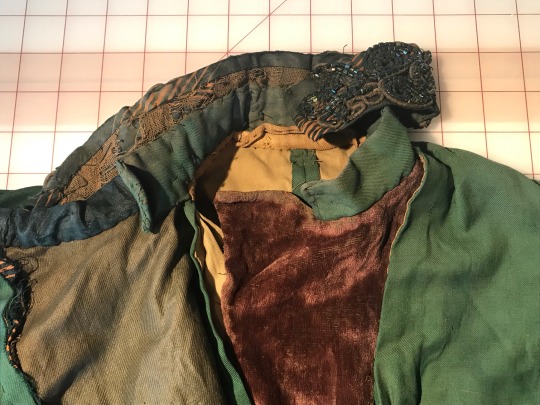
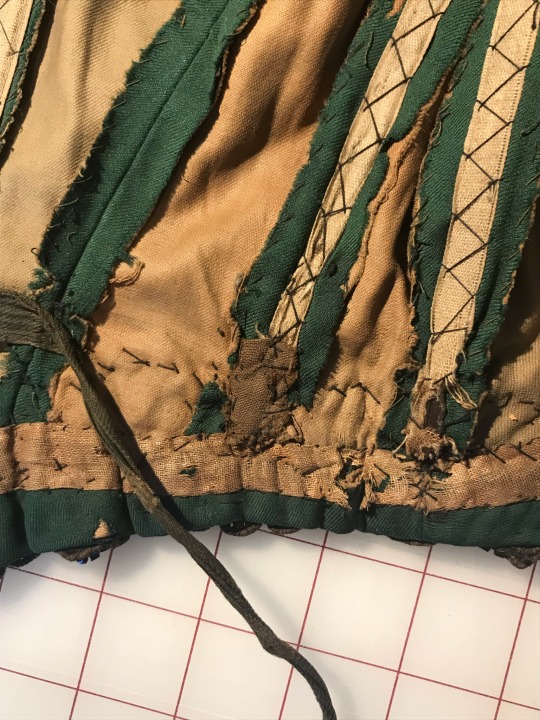


#1890s fashion#1890s#historical fashion#extant garments#victorian fashion#victorian#btw it was $16 dollars at an antique store#can you believe it#i will probably try to see if I can get some of these posed on maniquns later this year
126 notes
·
View notes
Note
the gilded age costuming is interesting in that they deliberately take inspiration from later designs for bertha and gladys to emphasise the “nouveau riche” while the old money characters will be clothed in more historically accurate fashions (some are even direct replicas of paintings/extant garments)
I do understand the urge to do that, and I know it's approach with a lot of historical costuming, but personally I dislike that approach. I think it misunderstands the point of fashion in Victorian society. Today we think of the most fashionable people to be very forward thinking in their fashion and for formal clothing to be most fashionable. Red carpet is often treated as fashion event. However, this was not the case in Victorian society. Fashion was social decorum, it was a requirement to participate in high society. Or rather it was requirement to participate in society at all. Even workers adhered to the fashionable silhouette, while working. Here's for example factory workers from mid 1890s with perfectly fashionable silhouettes with the big sleeves and all.

I think it's quite backwards to think nouveau rich would be experimenting with futuristic fashion. It's unthinkable they wouldn't adhere to the fashionable silhouette for high society events especially. They were the ones trying to establish themselves as part of high society, so they would be the ones most religiously following the fashionable silhouettes and styles. This is why tea gowns were much more experimental, and why the counter cultural Aesthetic style, which rejected the Victorian silhouette, could first entered high society through tea gowns. Tea gowns were worn in more intimate society gatherings (afternoon tea with neighbors and friends), so there was more room to experiment with new counter cultural styles. Tea gowns in 1880s had many of the elements that would become fashionable in 1890s, looser fit in bodice, natural form bustle and even balloon sleeves. Some British middle class/upper middle class women would dress in Aesthetic dress during 1880s in public society events, but they were not part of the upper echelon of high societies and no one dressed that way in high society evening events. The old money rich people also had more room to experiment with more unconventional fashion than nouveau rich, since their position in the exclusive high society was so much more secure, even if they were not as respectable (and adhering to the fashion ideals was about respectability) as expected of high society, their connections and status protected them from consequences. Money was not enough to secure your status, you needed connections.
107 notes
·
View notes
Text
☆Update 2:☆
I remembered to take pics today! Sort of. Only after i had put away my machines and stuff...
Here are (most) of my edwardian undergarments
(i am wearing modern clothes under bcs the internet is weird)
Chemise, bustle pad, underbust corset, petticoat
I still need to make a corset cover someday, ive just been using a second thin chemise over all this:
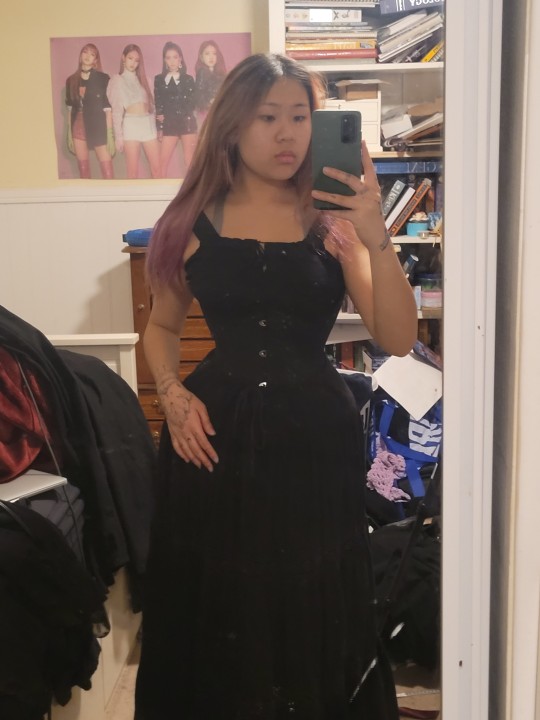
I used these vintage buttons on the cuffs. I wanted some more security but ran out of buttons so i used small snaps:
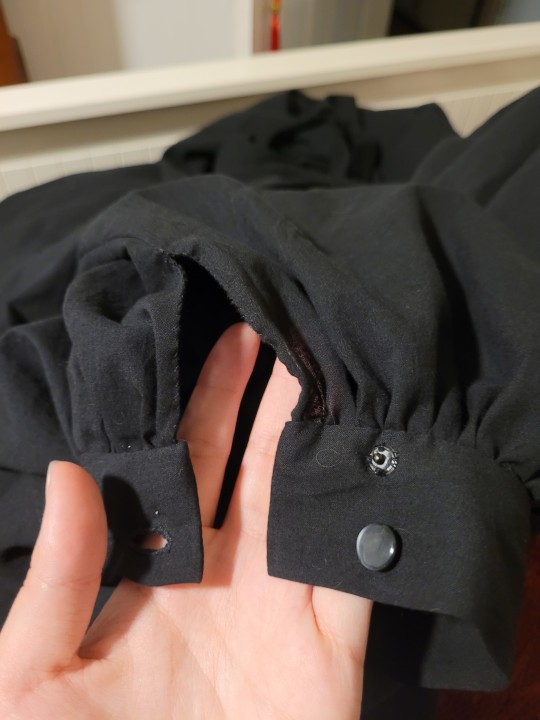
Also put one on the collar so i could try it on. I think the placket at the back of the blouse is a little ugly and larger than ive seen in extant garments but i forgot to adjust the pattern for my broad shoulders and need the extra width for comfort.

I tried on the blouse and skirt together:

I may need to loosen the waistband of the skirt, the corset is a bit bulkier than i thought itd be. Also the blouse is just stuffed into the skirt and currently only has one closure on at the collar so it looks a little bit disproportionate. The belt/sash will help smooth everything out so i dont look like im drowning in voile.
I might go without the bustle pad during the final shoot because i think it gives too much volume in the waist/hip area for edwardian tastes. Its from an 1890s pattern, so the silhouette is a bit out of date. I should probably try the skirt on without the pad before extending the waistband though.
Im pretty happy with how the sleeves turned out! I have some vintage nottingham lace i bought on etsy from penelope textiles that i was going to add to another project. I think ill sew some different laces together and add it to the cuffs to elongate them a bit. Since this dress is supposed to be from roughly 1905, i want the sleeves to look as they wouldve in that time. The photos ive seen mostly feature large ruffles at the ends of elbow-length sleeves but i dont think ill be likely to wear ruffles very often. Ive also seen tighter cuffs that extend from the elbow to mid-forearm or from the elbow to wrist. I think the elbow-length sleeves are a feature of afternoon dresses but i could be wrong. Maybe that was just day dresses? Not sure.
Im also not sure if i want to get gloves/a hat/parasol for this project. On one hand, it would look really cool for the video. On the other hand, it sounds quite expensive and i doubt ill wear it again. I dont want to buy things i wont use and create waste, theres enough of that in fashion. I have a pink 1900s parasol that i might cover with black fabric, but idk.
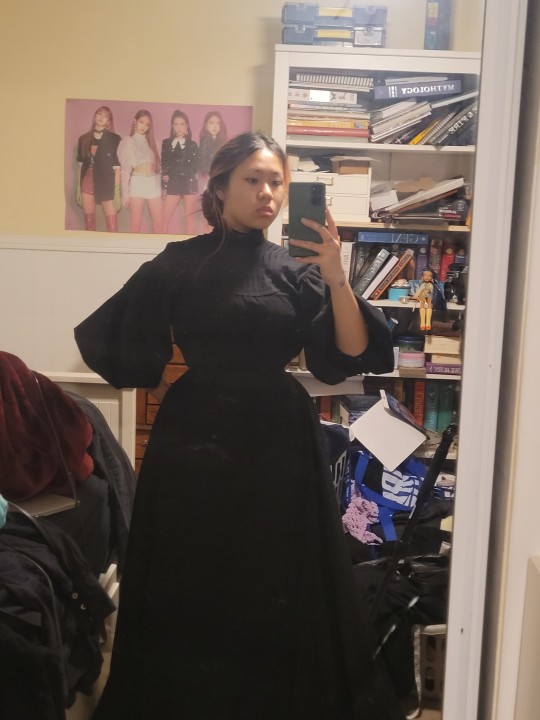
There isnt much left to do! Im gonna make a list here so i have it written somewhere:
-sew snaps onto blouse
-finish blouse hem
-attatch lace cuffs
-press pleats on sash/belt
-order synthetic whalebones
-add bones, hook/bars to belt
This is just the sewing tasks though, i need to edit the video clips and record audio. I have no idea how to do any of this. I just downloaded davinci video editor so hopefully i can figure it out. The only experience i have with video making/editing was in 3rd grade on ipads on the imovie app. Ive just been binge watching bernadette banner videos bcs i love her video style.
Any tips/feedback are much appreciated! ♡
Date: 4/22/24
#edwardian fashion#1900s#early 1900s#edwardian era#edwardian#victorian mourning#victorian dress#victorian era#victorian fashion#fashion history#historical costuming#historical dress#historical fashion
54 notes
·
View notes
Note
I'm new to the historical costuming and historybounding community and I noticed something odd and I wnated to know your opinion about it.
1850s/60s clothes are essentially nonexistent in the community at large. Every now and again, someone will make a Little Women inspired something, but that's it. No one seems to dislike this period, but no one seems to love it either?
Which confuses me so much because I would have assumed it to be one of the most popular styles, the way that the 1890s are in actuality.
Oh yeah, you're absolutely right! It IS rather underrepresented.
My main thought is that it's less practical for potential everyday modern wear than the later 19th century, and therefore less popular. Hoop skirts are marvelous, and not as huge or unwieldy as people like to think, but they're still not terribly practical for most people's lives nowadays. I adore the late 60s/early 70s elliptical skirt and bustle styles, but taking up so much space on the train would get me intense dirty looks at minimum. So I tend to aim a bit later- Natural Form or 1880s/90s transitional.
(Though I admit, it IS rather frustrating that almost every other daily wear historical costumer does 1890s/early 1900s. I want tips for styling a blouse so it looks less Edwardian Shirtwaist and more 1879 Blouse Waist, damnit! I can look at ads and photos and extant garments and fashion plates myself, but I'd love to have living people to compare notes with.)
I can recommend two bloggers who do more 1860s stuff, though: The Quintessential Clothes-Pen (Quinn Burgess) and Plaid Petticoats (Raven Stern). They do other eras as well, but it's not as much of an 1890s washout as popular costubers sometimes tend to be- with no hate intended to those people; that's just what they like to make! Neither of the bloggers I recommended are Everyday Victorian Clothing people, so that might contribute to their era flexibility.
Best of luck in finding your 1860s dream content!
(Also, if you DO want some more practical everyday 1860s, you could try looking at 1867-69; there was a brief A-line skirt moment there that everyone forgets about, but which would be less space-consuming than hoops.)
122 notes
·
View notes
Text
1895 EPQ Project: Part 1
The Foundation Layer
SO basically, in the 1890s you had 2 options for the layer closest to the skin: a chemise and drawers or a combination of the two (handily named combinations). I chose to make combinations since apparently they are more economical in terms of time and fabric, and as a broke busy teenager this suits me just fine.
I wanted my combinations to have 'split' drawers that close with buttons down the centre front. I chose a pattern from an 1895 sewing manual and made my design based on the my pattern, contemporary adverts and extant garments. If you look closely, there's a teensy dotted line on the pattern, I decided this was an option for a low neckline and used that.
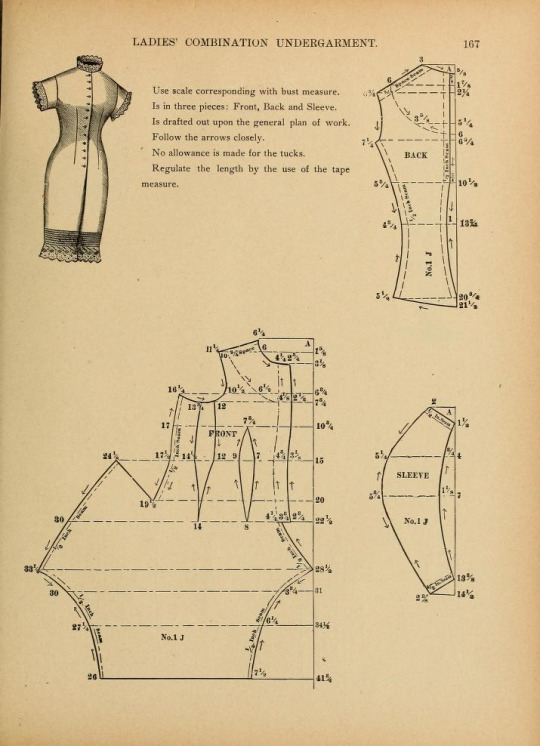
The pattern told me to use a 'scale corresponding with bust measure', however I don't really know 1) what that is, and 2) how to get one, so I decided to draft the pattern according to the scale given in the book and then fake it till you make it. I drafted the pattern pieces onto gridded pattern paper (honestly took me over an hour). I then marked the seam allowances and darts using a Frixion pen, which I cannot recommend enough because it comes right out when you iron it.
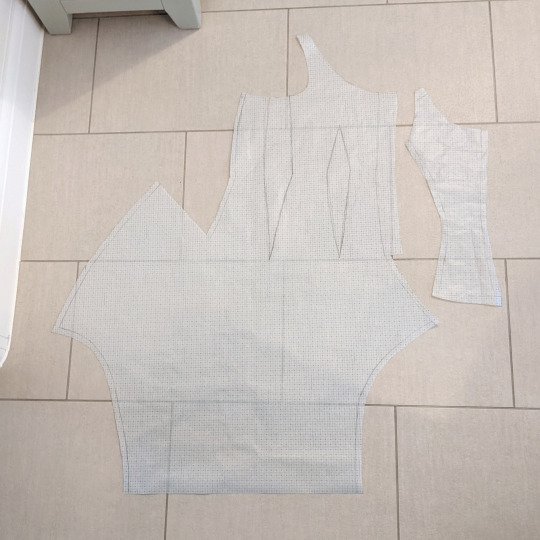
First I sewed the back pieces together with a French seam, then I sewed the darts. Next I sewed the fronts to the back piece at the sides and shoulders and flat felled it. This was the first point I could try it on and see if it fit, so naturally I did and naturally it didn't. So I re-sewed the darts until the fronts overlapped as they were meant to.

The next step was to sew the legs together up to where they meet and flat fell the seam. I then hemmed the raw edges of the split and gathered the rear flap (yes haha butt flap very funny) to fit the back panel.

Then it was placket time, babey. I used 8 buttons spaced 2 inches apart . As several extant garments I looked at used cloth covered buttons (these guys right here), I used plastic buttons covered in my fabric. I put the buttons on the left and the buttonholes on the right. Please don't look at them too closely, they are my second biggest weakness after hooks and eyes.
Then I sewed edging lace around the neckline, armholes and legs. I used reproduction lace from Etsy. Yes, it was expensive but it was really pretty so I didn't mind.
To sew it on (mini tutorial time):
Legs: I joined some insertion lace to some zigzag lace with a whipstitch. Then I top-stitched it to the fabric half an inch from the bottom, then folded the seam allowance into a hem and stitched it down (source)
Neckline: I topstitched the lace around 1/4 inches from the edge and trimmed the excess to about 1/8 inches and overcast it to the main fabric (source)
Armholes: I tacked the lace about 1/4 inches from the edge and then pinned and sewed bias binding on top through the lace. I then turned the bias binding to the wrong side and secured it with a whip stitch (source)


I meant to have pin tucks on the legs, but when I tried the finished combinations on they were already the right length so I couldn't have any.
And then it was done!

I'm really proud of this because this is by far the hardest garment I've ever made. Not necessarily the the physical putting together of it, but having to figure out the pattern and instructions myself. Even though there are a few places I wouldn't invite you to look at closely, I still like to think that someone, once, made some combinations that were much worse. And then they wore them every day.
My favourite part is the fact that this is school work. I get to work on my hobby then at the end of it I get a grade!
#this is long#historical costuming#historical clothing#historic fashion#historical dress#dress history#historical fashion#fashion history
26 notes
·
View notes
Text
History of Chinese standing collars (part 1: Ming & Qing)
So, a lot of people nowadays refer to a certain type of standing collar as a “Mandarin collar” but I'm not sure if that’s legit, because standing collars throughout Chinese history looked different. I was confronted by this topic when I was writing my post on 1950s Chinese fashion and felt like I had to make a separate post. I’m gonna do a quick break down of all the different types of standing collars in historical Chinese fashion from the 16th century to the present and how they developed.
Ming Dynasty (1368-1644)
The first mature 立领 liling standing collars were applied to women’s robes in the late 15th/early 16th century. Before any garment with a standing collar was invented, both men and women in Ming China wore garments with either a 圆领 yuanling round collar, 直领 zhiling parallel collar or 交领 jiaoling crossover collar, with crossover collars being the more common in womenswear.

Source here
Early Ming Dynasty portrait of a lady in a crossover collar robe.
The development of a standing collar was in large part thanks to the invention/adoption of the 子母扣 zimukou metal clasp button. I wonder why the fabric knotted buttons used on round collar robes were not used on standing collars in this period? They were awfully similar to the pankous of later. Anyway, at one point in the 15th century, some women thought it would be cool to add zimukou to their clothes and it resulted in this (they were also used on 比甲 bijia, 半臂 banbi and 短衫 duanshan but those are irrelevant to collars):
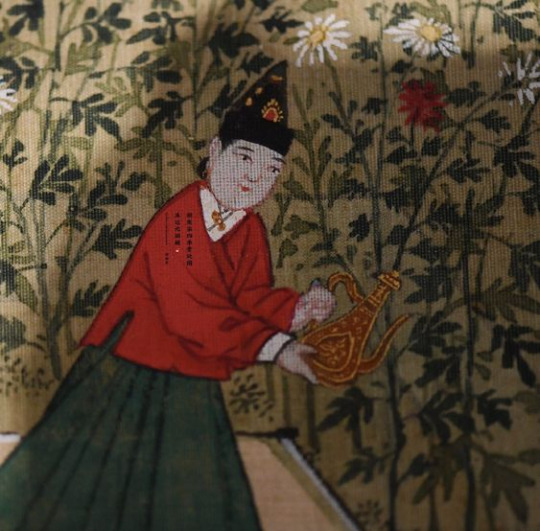
Source here
Part of 明宪宗元宵行乐图 (a painting depicting various Lantern Festival activities at the court of Emperor Xianzong), 1485. This lady is wearing a crossover collar robe with a zimukou at the middle.
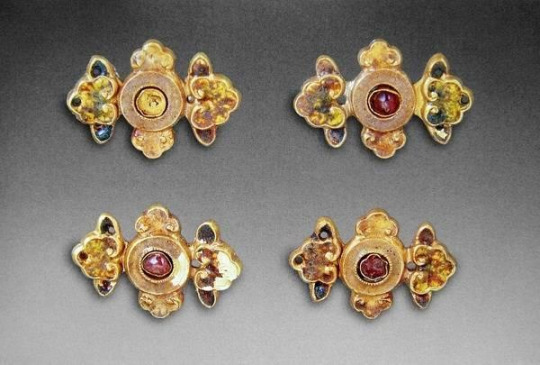
Source here
Modern reproduction zimukou. You could buy these for cheap on Taobao if you want to sew your own Ming style hanfu btw.
In the 16th century a fashion revolution took place in China: the standing collar, which came out of nowhere, began to suddenly dominate women’s clothing. This OG Chinese standing collar was very tall and form fitting, usually covering all of the wearer’s neck. It had sharp, rectangular edges and was closed by two zimukou, one placed at the bottom of the collar where it meets the bodice and another slightly above, not reaching the top of the collar. An important feature that set this apart from the collars of the 20th century is that it was unstiffened and made of the same fabric as the robe, meaning it was soft and could be worn with the top bit folded over, showing the lining which could be of a contrasting color. For archival purposes let’s call this collar style 1.
There are various theories as to why the standing collar was invented, e.g. because of colder climate during the little ice age, which peaked in the late 16th/early 17th century. Methinks it was just a fad which stayed.
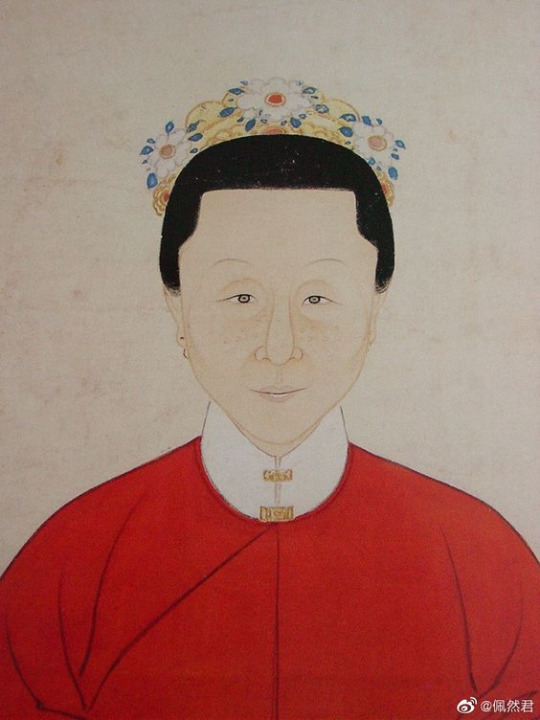
Source here
Late Ming Dynasty portrait, collar style 1.
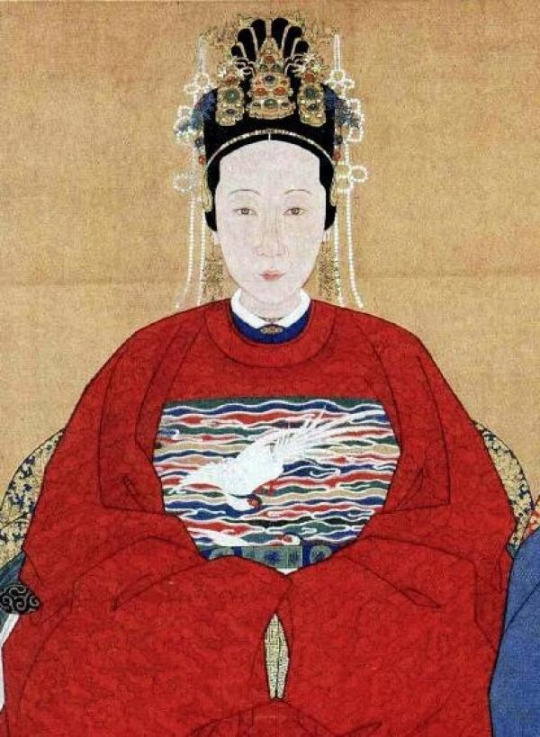
Source here
Late 16th century/early 17th century aristocratic lady wearing a standing collar robe underneath a round collar robe. The top of her collar is folded over. Collar style 1 variation 2.
Qing Dynasty (1644-1911)
This style of collar became the norm for Han Chinese women’s fashion in the mid to late 16th century and stayed that way throughout the 17th and 18th centuries. While the clothing silhouettes and accessories changed, the shape of the standing collar remained the same.
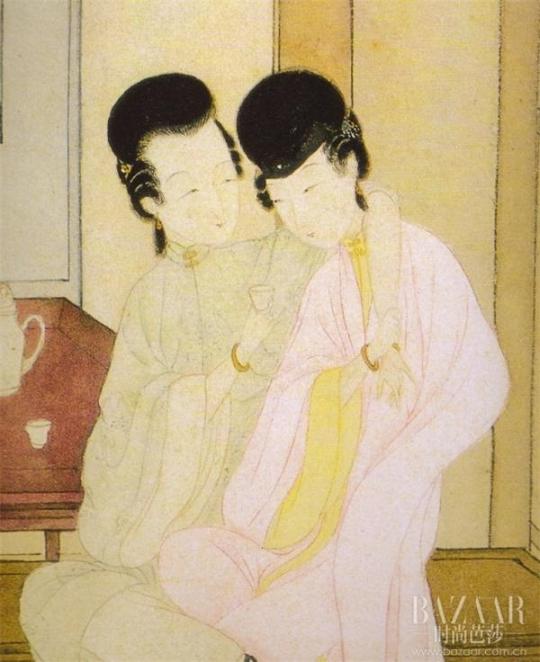
Source here
Late 17th century illustration for pornographic novel 肉蒲团 (1657). Collar style 1, but it became fashionable in the 17th century to have rows of piping around the neck for each button, so variation 3. Oh and wlw pride come throoouuuugh
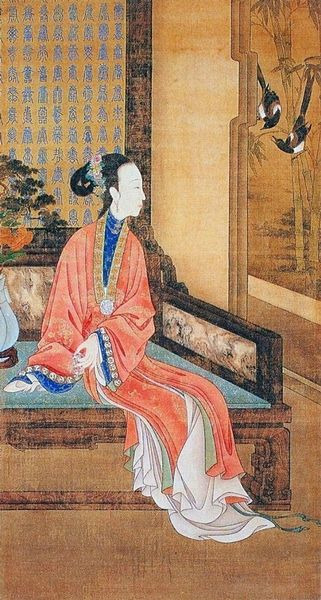
Source here
Early 18th century court painting, collar style 1 variation 3.
At some point in the late 18th century Han women decided it would be cool to use 盘扣 pankou, this fabric braided/knotted button of Manchu origin (more on Manchu dress later) on their collars instead of zimukou. The decoration also became more extravagant, with often rows of thick binding, piping or trim, corresponding to the decorations on the rest of the robe. It’s also slightly shorter, the upper button being at the very top of the collar. Let’s call this collar style 2.

Source here
(Presumably) late 18th century reverse glass painting showing collar style 2. The late 18th century deserves more attention, it’s such an important transitional period but also charming in its own way. This is true of European fashion of the period as well, I honestly love both places in the late 18th century.
In the beginning of the 19th century, the fashionable collar shape suddenly changed for some reason. It became extremely low, approximately only 1-2cm tall, only tall enough to accommodate one button. It still had crisp, rectangular edges. You could say this is another variation of collar style 2 but it is so iconic to the 19th century I think I’ll call this collar style 3.

Source here
Reverse glass painting ca. 1830. Han lady wearing a robe with collar style 3.
Now a brief look at Manchu womenswear. I am not an expert on Manchu historical fashion so tell me if I’m wrong. So the Manchus, who were apparently a confederation of Jurchen tribes from the area in what is northeastern China nowadays, invaded China successfully in the 1640s and remained the rulers of China until 1911 when they were replaced by the Republic of China. Throughout most of the Qing Dynasty Manchu women wore collarless robes, it was not until the mid 19th century that some Manchu women started to wear detachable collars to emulate Han women’s fashion, and not until around 1908 (!) when standing collars were actually added to their gowns themselves. Yes, period dramas did Manchu women dirty, poor gals have been dressed in the wrong costumes this, entire, time. The misrepresentation of Manchu historical fashion in the media in general is just fucking infuriating, but well, topic for a future post.

Source here
Late 17th century/early 18th century portrait of a Manchu lady. She is wearing a 衬衣 chenyi, a robe with straight sleeves, no slits and closed at the right side. It’s a casual gown worn for everyday activities. Her chenyi is collarless and the collar is closed by binding.
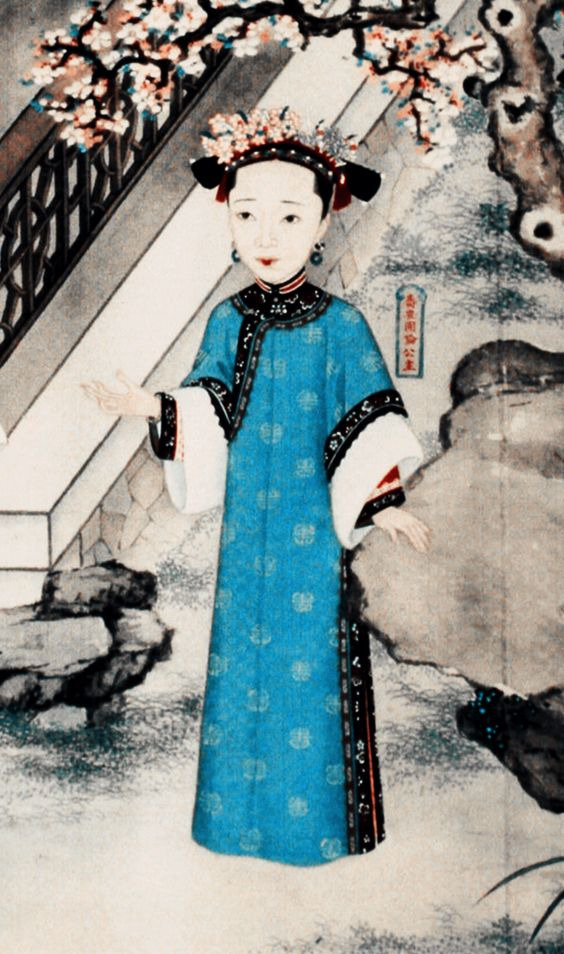
Source here
1840s/1850s court gown. She is wearing 氅衣 changyi (the bottom part of the first character should be 衣 not 毛 but this character is so obscure that it literally DOES NOT EXIST in the Chinese language anymore omg), a more elaborate style developed in the early 19th century with slits down both sides and wide trims along the collar, cuffs, side closure, side slits and hem. I have yet to see an extant example with a standing collar, all the changyi from the 19th century I’ve seen in museum collections are collarless, so the collar seen in paintings must’ve been detachable. Maybe some Manchu women liked Han women’s fashion and wanted to wear a detachable collar. I have, however, seen Manchu women’s vests and jackets with standing collars. These were similar to late 18th century Han women’s collars, so collar style 2.
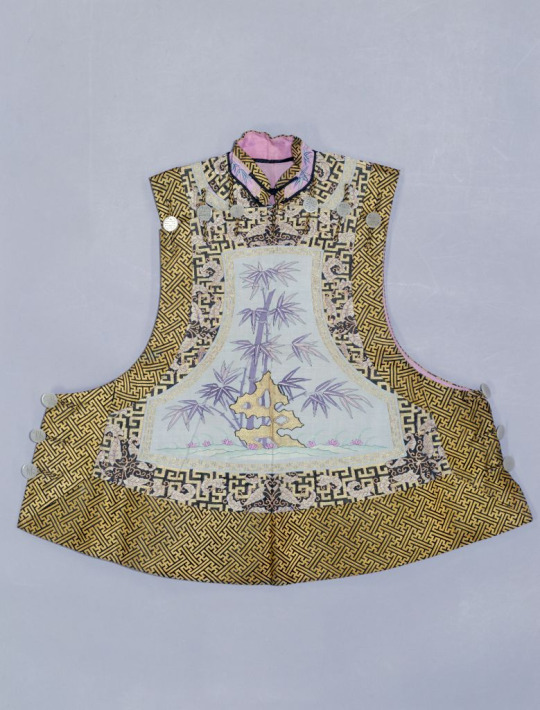
Source here
1890s/1900s women’s vest with collar style 2.
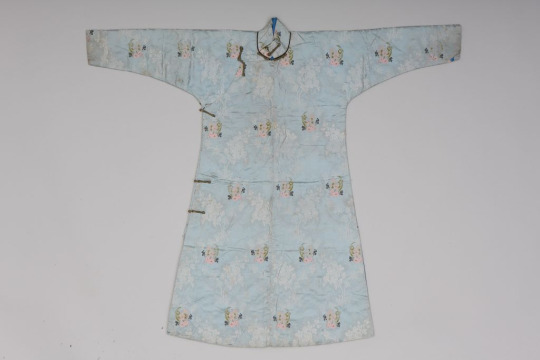
Source here
Ca. 1908. Chenyi with standing collar. If the passage of time is still not clear, notice the Western fabric used. Collar style 2.
At first glance this might look like a cheongsam but it is not. Chenyi did not have slits down the sides, unlike most 20th century cheongsam. It may have been a source of inspiration for cheongsam though, as I have explained in one of my 1930s posts, although the more obvious prototype for cheongsam was the changyi with slits and standing collars.
Let us now turn our attention to Manchu menswear, which is where things get complicated. In the 17th and 18th centuries, the Manchu riding habit, 行服袍 xingfupao, was a form fitting calf length robe with form fitting long sleeves and 马蹄袖 matixiu “horse hoof cuffs”, closed at the side with pankou. It was constructed in the same method as Han Chinese clothing. This original Manchu robe was collarless----I cannot stress this enough. The Manchus did not come barging into China wearing robes with standing collars goddamnit, get your facts right period dramas.

Source here
Portrait of Emperor Kangxi in a xingfupao. This is from the early 18th century already but the style didn’t change much so you get the idea. I love this color btw I think he looks great in it.
The xingfupao was an informal riding habit and only one small part in the gigantic system of Manchu court dress, the rules of which are well documented but I don’t bother to look them up. If you would like to do that, Google 大清会典. At one point in the early 18th century some Manchu dudes decided it was cool to add a collar to their xingfupao (like... Han women??) and it resulted in this:

Source here
An early example from the Kangxi era (1661-1722), a xingfupao with a standing collar of a contrasting color. The hem is detachable for horse riding (horse riding was an important aspect of Manchu culture and that influenced many of their fashion decisions). Judging by the fur lining I assume the standing collar was added for warmth in winter? I also saw some xingfupao with fur trim attached to standing collars so maybe that was the purpose.
Standing collars on xingfupao was constructed in a similar way to Han women’s collars, with rectangular edges and closed by two buttons. Pankous, which were unique to Manchu dress, were used instead of the Han zimukou. It appears that this collar was also soft and unstiffened, so it could be worn with the top bit folded over like in ye olde times (the 16th century). It’s important to note that xingfupao with a standing collar were not common at all, maybe a 1/20 probability to see in museum collections. Construction wise it’s similar to collar style 2 but it appeared earlier and was exclusive to menswear, so let’s call it collar style 4.

Source here
Qianlong era (1735-1796) portrait, xingfupao with standing collar of the same color folded over. Collar style 4 variation 2.
Another garment with a standing collar was the dress of the officials, known by white people as “Mandarins”. From the artworks and photographs I’ve seen, the collar only appeared in the outfit with a 行服褂 xingfugua, a button down tunic with straight, wide sleeves and slits at the front, back and sides. It was usually worn in combination with xingfupao, like how a shirt and vest are fixed combinations in European menswear. However, the collar of this kind of outfit was separate from the tunic itself. A plastron with an attached collar was worn underneath the robe and tunic (completely detachable collars were also used I think??) and the collar was buttoned from the inside. Not sure if this qualifies as a standing collar at all since it isn’t even attached to the robe itself, but anyway let’s just call this collar style 5.
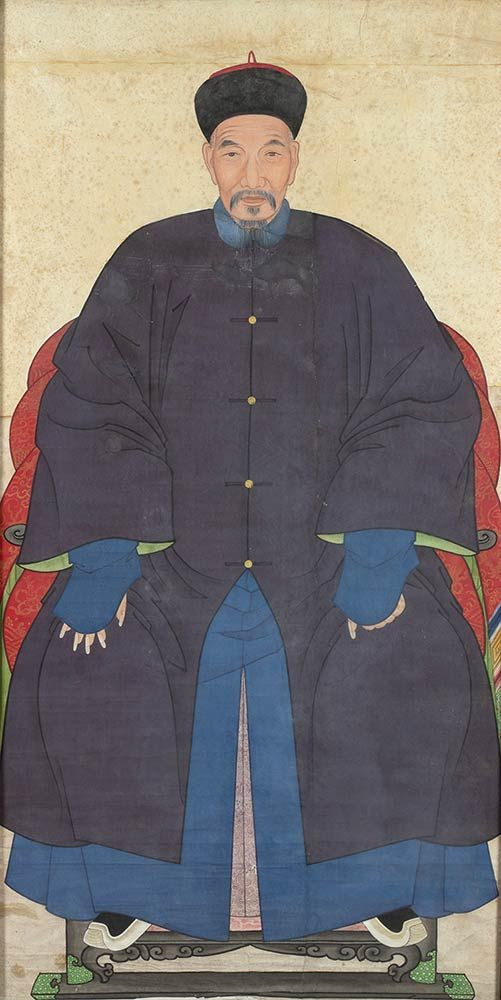
Source here
19th century portrait of an official. He is wearing a blue xingfupao, an indigo xingfugua and a blue detachable collar; a standard ensemble (well he’s also wearing pants and boots and stuff but that’s not the focus here). Collar style 5.
Oh I forgot to mention, after the Manchus took over China, they enforced their dress code on Han Chinese men but not Han Chinese women, so in the Qing Dynasty Han and Manchu menswear were one and the same but Han and Manchu womenswear were not.
I’ve only been talking about court dress so far, educated/well off civilian Han men would wear 长衫 changshan, a floor length robe, sometimes with a 马褂 magua, a short riding vest (derived from xingfugua), whereas poorer Han men would wear 短打 duanda, a short button down shirt, and pants. Well people who wore changshan also wore pants underneath but they’re not visible. All men wore pants tbh (incoming tangent), a while back when Harry Styles in a dress (which I stan) was making the rounds on social media some well meaning people were trying to find historical precedents for men wearing dresses and they named Chinese historical clothing as an example. I just wanna say, while I appreciate the sentiment, the harsh reality was that historical Han Chinese fashion was extremely gendered (except for a few brief time periods and a few select garments). Pants were reserved for men and skirts for women, the long gown like garments seen on men in historical portraiture were all robes, not dresses; you wouldn’t consider a long coat or bathrobe a dress nowadays, would you? Men always wore pants as undergarments while women wore petticoats. However I think that’s great for illustrating how our perception of whether a garment is masculine/feminine could change over time and that gender is socially constructed. Back to the main topic, to my knowledge, magua never had collars because it was a vest, changshan commonly had collars and duanda sometimes did too. I’m not sure when the standing collar began to appear on changshan, maybe when the court xingfupao gained collar style 4 it stuck in civilian fashion, maybe it was some point in the 19th century.
Anyway, fast forward to the late 19th century, the men’s changshan had a tall standing collar but again it was different to everything we’ve seen so far. It was exceptionally tall and had a smoothly tapering edge closed by only one pankou at the bottom. This resulted in a huge v shape gap down the middle. It’s still unstiffened but because of the lack of a rectangular edge it couldn’t be worn folded over. Let’s call this collar style 6.

Source here
Late 19th century/early 20th century portrait of a man. Changshan with collar style 6.
Let’s finish this part with Han women’s collars in the 1890s and 1900s. Around this time Han womenswear began to modernize and become simpler, but that trend did not apply to collars: the collars of Han women’s robes suddenly became unnaturally tall. They were so tall that they touched the wearer’s cheeks and couldn’t be closed at the front at all, kind of resembling Regency era European men’s collars?? This style of collar was oftentimes called 元宝领 yuanbaoling, ingot collar, or 马鞍领 ma’anling, saddle collar, after the object it resembles. Let’s call all of these tall collars that touch the wearer’s face collar style 7, but bear in mind these had a lot of variations.

Source here
Photograph from the 1900s. This could be categorized as a cursed variation of collar style 6 judging from how it only has one pankou and a tapering edge instead of a rectangular edge. But like, belle époque Chinese collars are a whole other species, so let’s comfortably call it collar style 7.

Source here
More collar style 7 representation. This collar style will never stop being funny to me, like just look at it it’s so tall.
So, in summary:
Collar style 1: OG Ming Dynasty standing collar, in fashion from the 16th to mid 18th century. Tall, unstiffened, rectangular edges. Closed with two zimukou. Could have piping (17th & early 18th century). Could be worn with top bit folded over (16th & early 17th century). Worn by Han women.
Collar style 2: developed from collar style 1, popularized in the late 18th century. Medium height, unstiffened, rectangular edges. Closed with two pankou/other fabric buttons. Commonly has binding, piping or trim. Worn by Han women in the late 18th century, partially adopted by Manchu women in the late 19th century.
Collar style 3: developed from collar style 2, exclusive to the 19th century. Extremely short, unstiffened, rectangular edges. Closed with one pankou. Commonly has binding, piping or trim. Worn by Han women.
Collar style 4: collar style 2 but simpler, appeared in the late 17th/early 18th century. Tall, unstiffened, rectangular edges. Closed with two pankou. Commonly plain. Worn by Manchu & Han men.
Collar style 5: detachable standing collar, a staple of official’s uniforms throughout the Qing Dynasty. Medium height, unstiffened, rectangular/rounded edges. Buttoned from the inside. Always plain. Worn by all officials (exclusively men in this era).
Collar style 6: civilian men’s collar characterized by v shape gap at the front, I don’t know when it first appeared, some point in the Qing Dynasty. Tall, unstiffened, rounded and dramatically tapering edges. Closed by one pankou. Worn by civilian Manchu & Han men.
Collar style 7: cursed belle époque (1890s & 1900s) women’s collars that touched the wearer’s face. Extremely tall, stiffened, both rounded and rectangular edges existed. Closed by one pankou at the bottom but sometimes had more pankou for ornamental purposes. Worn by Han women in this period.
Join me next time as we dive into the Republican era where things get extra complicated.
#hanfu#historic fashion#chinese fashion#chinese history#ming dynasty#qing dynasty#16th century#17th century#18th century#19th century
343 notes
·
View notes
Text

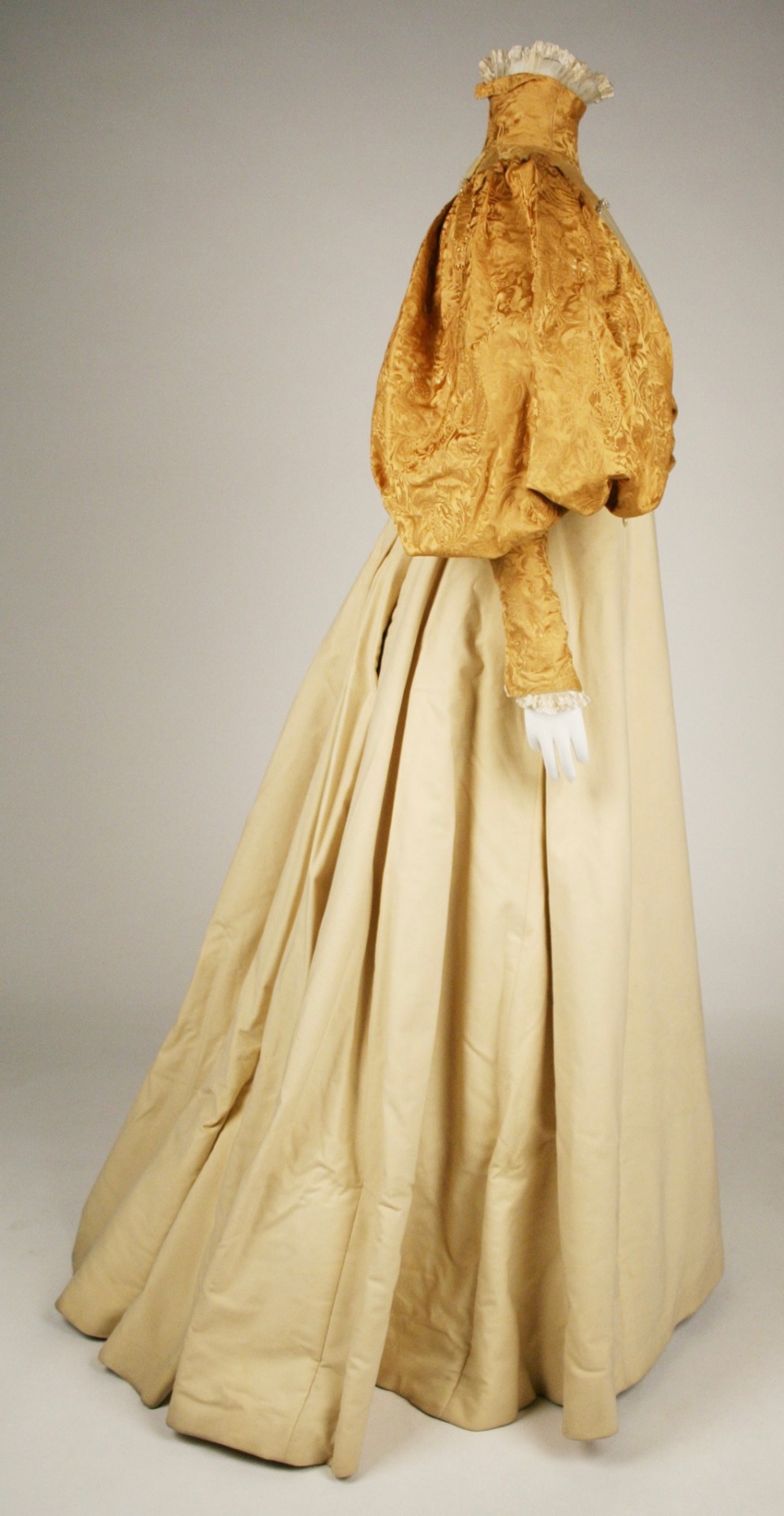

Beige and gold bridesmaid’s dress, 1896, American.
By A. F. Jammes.
Met Museum.
#womenswear#extant garments#dress#19th century#met museum#usa#1890s#1896#1890s dress#1890s extant garment#1890s usa#beige#gold#bridesmaid dress#1890s wedding#wedding#a. f. jammes
747 notes
·
View notes
Photo

Day dress by Paquin ca. 1895
From Tessier-Sarou
2K notes
·
View notes
Text
Women’s Outdoor Apparel: In Historical Context
If I had the opportunity to conduct a research project with unlimited funds, I would do it on the history of women’s outdoor gear. Historical Fashion has always fascinated me, and in recent years my attention has been drawn to the severe gaps that remain in outdoor gear and apparel aimed toward women. For instance, there is an ongoing joke between my friends and I (that has proved true many a time) that all financially accessible women’s outdoor apparel companies only make outdoor wear in the colours black, fuchsia, or teal. Historically, women’s active and outdoors wear has always been a few steps behind that of men.
For example, in 1943 most male sports players were fighting overseas in World War 2, and Philip Wrigley formed the All-American Girls Professional Baseball team, on which the players wore a one-piece skirted uniform as opposed to pants. Women were meant to “look like ladies, but play like gentlemen” (Porter, 2020). From my 11 years playing Softball, I can tell you that sliding into home with anything less than full length pants and sliding pads will leave you with some very unladylike scars.
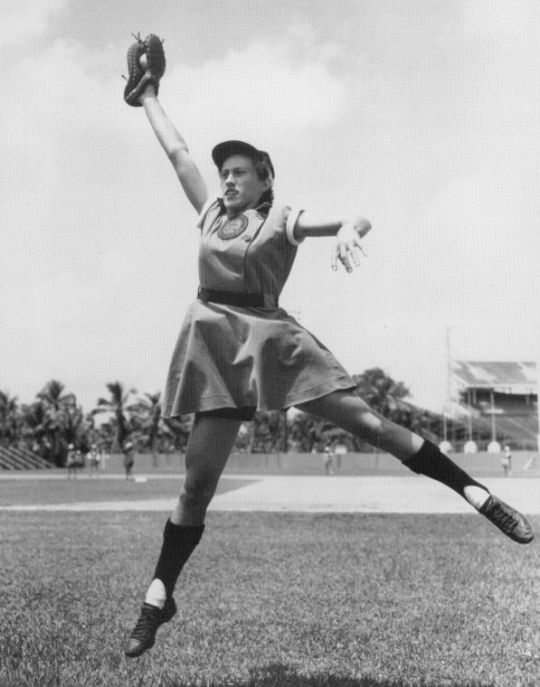
Dorothy “Dottie” Kamenshek, First Basemen for the Rockford Peaches jumping to catch a ball in her uniform, from the National Baseball Hall of Fame, from: https://www.enidnews.com/news/league-of-their-own-women-baseball-players-together-again/article_aa96deac-d474-5e3e-8fa6-9443f239aa89.html
In another example, the 19th century and industrial revolution led to much more expendable income in families and led to more women joining their husbands in outdoor pursuits like yachting and mountain climbing. MacIntosh rubberized-cotton raincoats were patented in 1823 and became quite popular in 1830 following their roll-out to military men, but the popularization of waterproof outerwear for women and subsequent design of fashionable styles would not come until the 1880s and 1890s (Shepard, 2012).
If I had unlimited resources, I would do a deep dive into the history of women’s outdoor wear from woolen shawls and tunics to Helly Hansen Jackets, complete with trips to fashion museums to view extant garments, conversations with historians and modern garment makers, and a look into why so many gaps between men’s and women’s outdoor wear exists.
Ethically, this project would ideally not be a large undertaking. It would focus mainly on compiling existent research and speaking with experts only on the basis of their past research and findings, so factors like engagement with vulnerable persons, power imbalances, and most risk factors would likely be easier to avoid. However, there is always economic and social risks to these experts should they speak ill of their institutions or design companies, so this would need to be addressed. Of course, free and informed consent is also a factor in these interviews, as is respecting participant privacy.
This research would be proposed as a way to help outdoor gear and apparel companies better connect to the wants and needs of outdoorswomen, and as a way to bridge the gap between fashion design and user practicality. It would help gear companies and women by furthering the conversation around past and current inequities between men’s and women’s ability to access the outdoors. It would help expedition leaders and companies in better addressing the gear needs of women who enter their programs.
Reference List:
Porter, M. (2011, March 27). When women ruled baseball: The AAGPBL. HowTheyPlay. Retrieved January 29, 2022, from https://howtheyplay.com/team-sports/When-Girls-Ruled-Baseball
Shephard, A. J. (2012). Waterproof dress : An exploration of development and design from 1880 through 1895. Clothing and Textiles Research Journal, 30(3). https://doi.org/10.32469/10355/6182
3 notes
·
View notes
Text

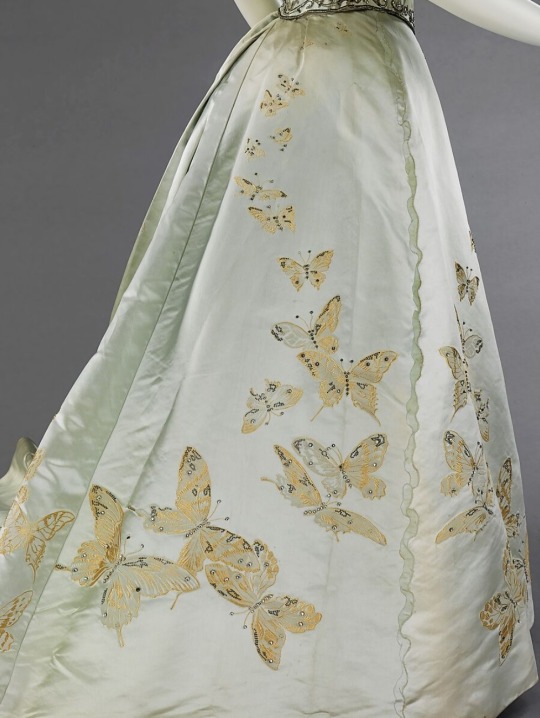

Title: Ball gown
Design House: House of Worth (French, 1858–1956)
Designer: Jean-Philippe Worth (French, 1856–1926)
Date: 1898
Culture: French
Medium: silk, rhinestones, metal
This gown is made from a very special fabric which was woven à la disposition to fit the shape and dimensions of the skirt so that the butterflies flutter upward from the hem and, being graduated in size, seem to disappear in the distance.
#historical fashion#fashion history#ball gown#house of worth#late victorian fashion#1890s fashion#extant garments
97 notes
·
View notes
Text
Making a Robe à la Polonaise (Part 4 - final)
Aaand my gown is complete!

I have to admit, I pretty much already finished it on Sunday, but I had some final touches to make which I did today so now I can finally officially say, it is complete.
First of all, if anyone remembers my seams from my other 18th century gown, please forgive me but also know that thanks to this blog, my sewing has gotten so much neater and I love it so much! If I’m sewing just for myself, I usually don’t care about the little things but I think I will now because it makes such a big difference! It looks so much more professional.
But anyways, I left off in my last post with just the bodice finished, so now I had to add the skirt - my favorite and the easiest part. I cut a rectangle of 180cm+110cm (the 110 obviously just depend on your height from the waist down to the floor, but make sure not to forget the undergarments and a pannier/bumroll! It will add a few cm). I cut it out with a very useful technique I learned from watching Bernadette Banner’s videos, which involves pulling out a single thread from the piece of fabric at the point you want to cut it. This way you can cut the straightest line across! I only use it when I have to cut very big panels that aren’t that easy to just measure evenly and draw a line across.
I did it by cutting a tiny bit into the fabric where I’ll pull out the thread and then I used some tweezers to pull out the thread. You have to be really careful and patient, the thread might break a few times especially if you’re doing this for the first time but you’ll get the hang of it!
And then I finished all the seams except for the bottom one.
After that, I measured around my waist to the points in the front where I want the skirt to end as it doesn’t close all the way in the front. Technically you should follow the edges of the bodice but I didn’t think of that so I just measured my waist but it still worked. Now I knew when I would pleat the top edge of the skirt, how small it had to become when pleated. In a weird way, I made tiny pleats of maybe half a cm all the way across and it was close enough to the length I needed it to be, so I left it as it was.

I then secured the pleats by stitching over them. You don’t really have to do this as they’ll be secured enough when you sew them to your bodice but I just didn’t want the mess of having so many pins to take care of that would just be in the way so I just did this real quick.

Afterwards, I pinned the pleated fabric to the bodice right sides facing together and stitched it up to the waist seams. I made a point of not going further because I wanted the front piece of the bodice to lay on top of the front piece of the skirt. I saw that in photos of extant garments so I’m just assuming that’s one way to do it. So I tried to lay the bodice on top of the pleats so I could now stitch the edge of the bodice to that skirt to have it visibly be on top.
The dress was now way too long on me so I folded the bottom over by a few centimeters and finished the seam.

I generally like wide bottom seams. I know it’s not really a thing but I just like them that way!
Now came the challenging part. Originally, I’d given up making that one gray gown into a Robe à la Polonaise because I could not figure out how to drape it properly. But thankfully, while I was researching something completely different (that I’ll hopefully make a post about soon, as soon as I can gather enough information about it), I came across an article explaining that they would attach small rings to the underside of the skirt to pull a ribbon through it. I didn’t really find anything that could work, but from making my 1890s corset, I still had some eyelet plates (idk what they’re called), they were a little flat but they would work while I would be looking for something more fitting. So I measured exactly where I wanted to pin the skirt up and sewed six rings to each side, each 19cm apart. Then I put the band through.


Sorry for my orange nail, it stained from dying my hair red)
Finally, the hooks at the front of the bodice and I was ready to wear it! To be completely honest, yes, it has some flaws but it still felt like I was wearing something straight out of the movies, or another world. I have to use a fichu, not just because it was actually fashionable back then but also because my stays are a little visible at the neckline. I do have another pair of stays, maybe it works better with those, I haven’t tried them yet.
But anyways, here she is - my ca. 1775 (stays are 1750s) Robe à la Polonaise.

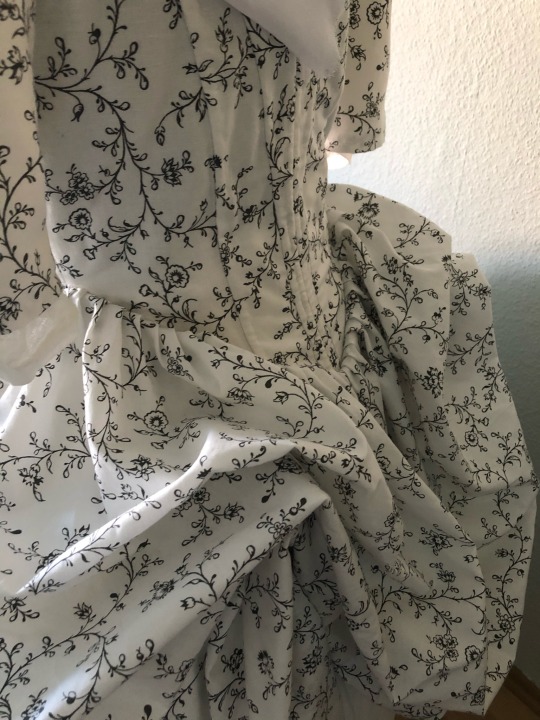


The photoshoot I talked about is going to happen at some point in the future. It’s very hot at the moment and I’m barely venturing out in shorts, I’ll have to wait until it’s more bearable to wear all those layers! (Also, I have to build up the courage to go outside in 1770s wear.)
All in all I’d say that this is definitely my favorite thing I’ve ever made. I’m still so in love with that fabric!
#fashion#historical fashion#fashion history#sewing#rococo#rococo fashion#robe a la polonaise#georgian gown#georgian fashion#rococo dress#rococo gown#mysewingadventures
25 notes
·
View notes
Text
Dress History Corner Navigation
Welcome to the corner of the interned where I nerd about (mostly) Western dress history! This is the post I will update with all my more structured and researched articles. I have the same navigation on my blog, but it's only for the browser so I figured it would be useful to have navigation that work for the app too.
Some basics
An Introductory Timeline Of Western Women's Fashion
How I do my research into dress history
Dress History
Lacing in Western Fashion History
Dress Etiquette Thorough Western History
When Did It Become Acceptable For Western Women To Wear Pants?
When Did Skirts Stop Being Acceptable For Western Men To Wear?
Is Lingerie Going Backwards - A Rebuttal
The history of showing your boobs for fashion
Victorian Era
A summary of different kinds of corsets
Historical Finnish Clothing of Modern Period
Victorian Dress For Every Occasion - 1890s Edition
1890s Day Dresses
American Civil War era (1861-65) ball gown
Regency
Debunking the common narrative about Beau Brummel - The whole modern men's fashion is not the fault of One Guy
Gender non-conforming Regency styles
18th century
The Colonial History of How Cotton Became the Most Important Fabric
Mantua And It's Variants
Northern Italian countryside fashion in late 18th century.
Working Class Clothing In Late 18th Century France
Early Modern Era
Deep Dive into 15th and 16th Century Working Class Fashion in Western Europe
Medieval Era
Late 14th to Early 15th Century Bohemian and German Men's Fashion
Construction of Men's Hose
Codpiece
Construction of the French hood
Iron Age
Viking and Crusader Age Finnish men's dress
Historical Sewing
Sewing Medieval Bathhouse Dress
Historical Costuming
History of the Fantasy Corset
Met Gala 2022 Costume Commentary
Pride and Prejudice 2005 Costume Analysis
Ranking Men's Costumes in Renaissance Period Dramas - Part I: The Bad
Ranking Men's Costumes in Renaissance Period Dramas - Part II: The Good
Textiles
Hemp's properties
Sustainability
How to see through the greenwashing propaganda of the fashion industry - Case study 1: Shein
The Real Cost of the Fashion Industry
Architectural History
History of Sauna and Steam Baths
Historical Queer Figures
Julie d'Aubigny
History
Palestinian History Between Great Powers
European History Is Not White
Tag Navigation
#answers
#resources
Primary sources
#primary sources
#extant garment
#photograph
#painting
#illustration
#fashion plate
Pinterest Boards
Victorian Fashion
#i actually don't currently have the exact same navigation on the blog but i will once i get around updating it lol#fashion history#dress history#history#historical sewing#historical costuming#textiles#textile history#architectural history#architecture#historical resources#navigation#nav
211 notes
·
View notes